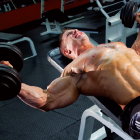 Q: I have seen flyes performed three different ways: with arms almost straight and a very deep stretch, with arms slightly bent and with arms bent to where it almost looks like a press. Your chest is huge, so how do you do them—and how far do you stretch?
Q: I have seen flyes performed three different ways: with arms almost straight and a very deep stretch, with arms slightly bent and with arms bent to where it almost looks like a press. Your chest is huge, so how do you do them—and how far do you stretch?
A. My chest is definitely the part of my physique that receives the most attention, and I will never get tired of the comparisons to Arnold! Without a doubt my chest thickness has manifested through very hard work on a combination of movements, which include presses and flyes (of various types and angles) as well as dips and pullovers.
When it comes to flyes in particular, I definitely have my own style, and it came about through plenty of experimentation. At first I tried to mimic what I saw other “big guys” in the gym doing, but I soon realized that what may work for others wouldn’t necessarily work for me. It was time to find my own groove.
The major advantage of flyes, as opposed to presses, is the tremendous stretch you can get across the entire pectoral region. That’s important because a powerful growth-signal is produced when a muscle is stretched under tension. Research has shown that when a muscle is made to stretch forcefully, it will produce greater amounts of a hormone called IGF-1—insulinllike growth factor 1—one of our major hypertrophy-inducing hormones, and will also ignite satellite cell proliferation, which is an essential part of the anabolic process. So despite the fact that you can’t use nearly as much weight on flyes as you can on presses, the flye is an equally important part of any pec-pounding program!
When I perform flyes, before I even start the movement, I make sure my torso is in the proper position for max pectoral recruitment. In other words, I do not want the exercise to blast my front delts harder than my chest. I begin by grabbing a pair of dumbbells that will allow me to reach failure in whatever rep range I’m shooting for. I then sit on the end of the bench with the ’bells on my knees. As I lie backward, I kick them back toward my chest. Once in position, I raise my rib cage high and shrug and roll my shoulders downward, leaving a slight arch in my lower back. Now my torso is in the perfect alignment to attack every fiber in my pecs.
Of the three performance styles you mentioned, I would say that I am somewhere between slightly bent and almost looking like I’m doing a press. Although I may not do what looks like a traditional flye, I’m in no way pressing during the exercise. My initial movement is definitely in the form of an arc and not a line straight up and down.
Also, I do my eccentric contraction very slowly, about three to four seconds most of the time. I make sure that my pecs are always under full tension and that my arc is precise. At the bottom I hold for a second or two to get a very deep stretch while consciously forcing my rib cage up further to make the stretch even more severe. At no point, however, do I feel I’m overstretching my shoulder capsule—I only experience the burn through my chest. From the stretch position I focus on contracting only my pecs to slowly bring the ’bells back through the same arc into the starting position, about three to four inches from one another at the top.
Editor’s note: Eric Broser’s new DVD “Power/Rep Range/Shock Max-Mass Training System” is available at Home-Gym.com. His e-books, Power/Rep Range/Shock Workout and The FD/FS Mass-Shock Workout, which include complete printable workout templates and Q&A sections, are available at
X-Workouts.com.




















You must be logged in to post a comment Login